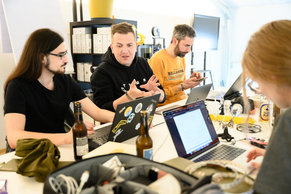
Organizational Integration
The integration of two businesses after a merger or acquisition. Also applies to integration of departments due to organizational structure changes such as a reorganization.Corporate Culture Integration
Corporate culture clashes are often identified as a risk to organizational integration. As such, special programs may be initiated to clearly define the culture of the integrated organization, communication it and reward those who embrace it.Business Process Integration
Business requirements to have two or more processes work together by sharing data and events.Process Integration
The integration of processes, typically at the event level using technologies such as an enterprise service bus, workflow engine or process automation tool.Data Integration
Combining data from various sources to support processes, user interfaces or reporting.System Integration
Integration at the system or application level, often to produce a unified user interface.B2b Integration
Integration with an external organization such as an information provider, partner or customer.Enterprise Application Integration
A category of technology, also known as middleware, that supports integration of systems, processes and data.Point To Point
Integration from one source to another. A point-to-point architecture is often implemented as a tactical method to get the data a project needs as cheaply as possible. With time, point-to-point integrations tend to grow and often number in the thousands for a large organization. This can become a maintenance nightmare as each change to a data schema breaks dozens of integrations.Batch Integration
Interfaces that combine data from one source to another on a scheduled basis as opposed to real time.Service Oriented Architecture
An architecture that wraps common functions such as integration services in loosely coupled, reusable, autonomous, stateless, discoverable and interoperable services. Service oriented architectures are intended to be highly reusable and address the tendency for integration functionality to become a mess of duplicated and high maintenance interfaces.Common Information Model
One of the primary challenges of data integration is that every system and process tends to have very different data definitions. A common information model is a cross-organizational data definition that is used to build integration services. A common model is also useful as a reference and for building new applications.Application Program Interface
An application programming interface is a library of code wrapped in interfaces that is offered by a particular technology platform or system. In some cases, these are opened up to remote access and can be used as a tool of integration. In such cases, it's possible to build integrated processes by executing code on a variety of platforms.Data Warehousing
Central repositories of data from a variety of sources that act as a single source of information for reporting and data analysis functions.Code Integration
Combining the code written by multiple developers or for different projects into a single release.Continuous Integration
A process of integrating the code of multiple developers on the same project several times a day.Mashup
A mashup is a user interface that combines information from a variety of sources. It is often used as a cheaper and faster alternative to data integration at the system or process level.Project Integration
The integration aspects of a project including organizational structures, processes, data, code and documentation.| Overview: Integration | ||
Type | ||
Definition | Interconnecting processes, information and organizational elements. | |
Related Concepts | ||






















